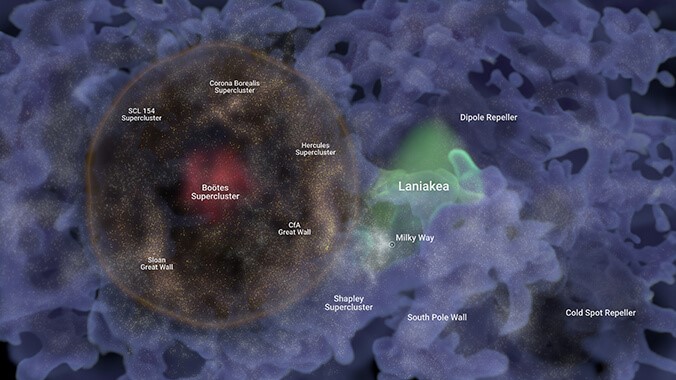Mysterious 'fossilized' bubble 10,000 times the size of the Milky Way could be a relic from the Big Bang
Astronomers have spotted a gigantic void they believe to be a baryon acoustic oscillation — a relic from when the universe was a fiery plasma soup.

A mysterious structure nearly 1 billion light-years across has been found in our cosmic neighborhood, and it could be a relic from the Big Bang.
The structure, consisting of a group of galaxies clustered around a gigantic spherical void just 820 million light years from the Milky Way, has been named Ho'oleilana, a name inspired by the Hawaiian creation chant, Kumulipo.
It is believed to be a baryon acoustic oscillation, a pressure wave frozen in time from the beginning of the cosmos and then stretched out to galactic scales by the universe’s expansion. The researchers who stumbled upon the weird relic published their findings Sept. 5 in The Astrophysical Journal.
"We were not looking for it. It is so huge that it spills to the edges of the sector of the sky that we were analyzing," Brent Tully, an astronomer at the University of Hawai'i at Manoa, said in a statement.
Related: Cosmic record holders: The 12 biggest objects in the universe
The sheer size of the bubble defies expectations and could imply the universe is expanding more rapidly than we thought, Tully said in the statement.
According to the standard model of cosmology, the universe began taking shape after the Big Bang, when the young cosmos was a roiling plasma broth of matter and antimatter particles that popped into existence only to annihilate each other upon contact. The force of gravity compressed these plasma pockets in on themselves, squeezing and heating the matter until sound waves traveling at half the speed of light — called baryon acoustic oscillations — rippled outward from the plasma clumps.
Sign up for the Live Science daily newsletter now
Get the world’s most fascinating discoveries delivered straight to your inbox.
These ripples pushed away the matter that hadn't already been drawn into the center of a clump. This outward-flung matter then cooled as a halo around the clump. At that point, most of the universe's matter, slowly congealing into stars and then galaxies, was distributed as a series of thin films surrounding countless cosmic voids — like a foamy mass of soap bubbles in a sink.
The astronomers found the gigantic void by chance while compiling a catalog of 55,877 galaxies, which they mapped to reveal patterns in their spacing. From this map emerged a ring 1 billion light years wide, its circumference dotted with galaxies and connected to cosmic filaments, and its interior empty aside from a galaxy supercluster called the Boötes Supercluster in its center.
"I am the cartographer of the group, and mapping Hoʻoleilana in three dimensions helps us understand its content and relationship with its surroundings," Daniel Pomarede, a cosmographer at CEA Paris-Saclay University in France, said in the statement. "It was an amazing process to construct this map and see how the giant shell structure of Hoʻoleilana is composed of elements that were identified in the past as being themselves some of the largest structures of the universe."
Because Hoʻoleilana is bigger than most baryon acoustic oscillations, the researchers think it could be a sign the universe is expanding at a faster rate than first thought — at roughly 76.9 kilometers per second per megaparsec, as opposed to the standard range of 67 to 74.
To find out if this is true, they say that they will make even more detailed observations of the petrified cosmic bubble.

Ben Turner is a U.K. based staff writer at Live Science. He covers physics and astronomy, among other topics like tech and climate change. He graduated from University College London with a degree in particle physics before training as a journalist. When he's not writing, Ben enjoys reading literature, playing the guitar and embarrassing himself with chess.










